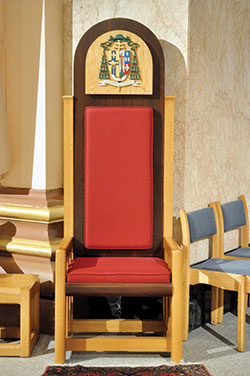Canon law provides for the governance of the archdiocese during transition

The cathedra, the ceremonial seat of the archbishop of Indianapolis, sits empty in SS. Peter and Paul Cathedral in Indianapolis on Nov. 8, the day after Cardinal-designate Joseph W. Tobin was announced as the new archbishop of Newark, N.J. While the cathedra will remain unused until the appointment of a new archbishop of Indianapolis, the Church’s Code of Canon Law provides for the steady day-to-day governance of the Church in central and southern Indiana in the interim. (Photo by Sean Gallagher)
By Sean Gallagher
The Nov. 7 announcement of the appointment of Cardinal-designate Joseph W. Tobin as Archbishop of Newark, N.J., has left the Archdiocese of Indianapolis for the time without an archbishop.
But the Church’s Code of Canon Law provides for the steady day-to-day leadership of the archdiocese until the pope appoints a new shepherd to lead the Church in central and southern Indiana.
Father Joseph Newton, who leads the archdiocese’s Metropolitan Tribunal as vicar judicial, said that the guidance canon law gives the archdiocese in this situation is a blessing.
“The law tells us that it is going to be all right, there are real and practical mechanisms in place that see to it that the people of the archdiocese are taken care of, that their needs are met, and that the sacramental life of the Church continues,” he said. “We are sad at the loss of [Cardinal-designate] Tobin, but the law gives us the room to grieve, to process, to heal and to hope, knowing that we are in the good hands of an archdiocesan administrator as we await our new local shepherd.”
Father Newton explained how the archdiocese will be governed during the time from the announcement of Cardinal-designate Tobin’s appointment to Newark and the choosing of a new archbishop of Indianapolis.
The following is a summary of that explanation.
At the time of the announcement of Cardinal-designate Tobin’s appointment to the Archdiocese of Newark, he ceased to be the archbishop of Indianapolis and became its archdiocesan administrator.
Cardinal-designate Tobin’s authority as such is more limited than when he served as archbishop. The main canonical principle that governs the archdiocese in the absence of an archbishop is that “no innovation is to be made” (Canon 428 §1).
For example, Cardinal-designate Tobin cannot make any significant changes to the archdiocese that should be left to the next archbishop, such as doing “anything which could in any way prejudice the rights of the diocese or of the bishop” (Can. 428 §2), like merging parishes.
Using the authority given to him in canon law, Cardinal-designate Tobin delegated his authority to issue various dispensations and allowances—often related to marriage cases—to Msgr. William F. Stumpf, Father Joseph Feltz and Father Newton. This delegated authority remains in place until a new archbishop is appointed.
Also at the time of the announcement of his appointment, Msgr. Stumpf and Father Feltz ceased to serve in their respective offices of vicar general and vicar for clergy. However, with regard to the role of the vicar judicial, canon law stipulates that it is to remain in place for continuation of the administration of justice; thus Father Newton will continue to minister as vicar judicial.
Msgr. Stumpf will also continue to serve as moderator of the curia, overseeing the various archdiocesan offices and agencies. Cardinal-designate Tobin has also, according to the allowance given him by canon law, granted him the authority of vicar general, although without the title of the office.
Father Feltz will continue to serve as vice-chancellor and director of the archdiocesan Office of Clergy, Religious and Parish Life Coordinators.
Cardinal-designate Tobin will cease to be archdiocesan administrator when he is installed as Archbishop of Newark on Jan. 6.
At that time, the archdiocesan priests who serve on a board called the College of Consultors will meet to elect a priest of the Archdiocese of Indianapolis to serve as the archdiocesan administrator until a new archbishop is appointed.
Once elected, the archdiocesan administrator has the authority of a bishop, overseeing the day-to-day governance of the archdiocese, but making no significant changes that should be left to the discretion of the next archbishop.
For example, he may celebrate the sacrament of confirmation and may also appoint priests to serve in parishes as associate pastors or administrators. He may not appoint them as pastors unless one year has passed and no new archbishop has been appointed.
With the consent of the College of Consultors, the archdiocesan administrator can authorize the ordination of priests or deacons of the archdiocese.
On the other hand, the archdiocesan administrator may not merge parishes or grant excardination or incardination to clergy—allowing archdiocesan clergy to become priests of a religious order or another diocese or allowing clergy from a religious order or another diocese to become an archdiocesan priest.
The archdiocesan administrator ceases from his office in ordinary circumstances when a new archbishop is installed. †
See more news from this appointment
